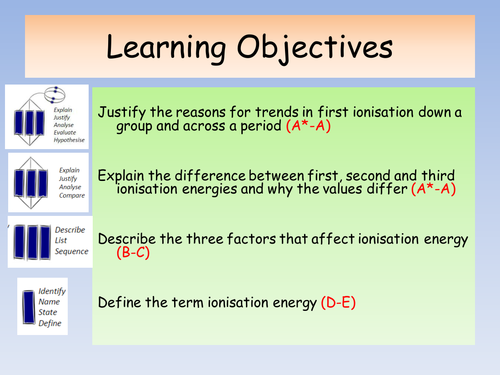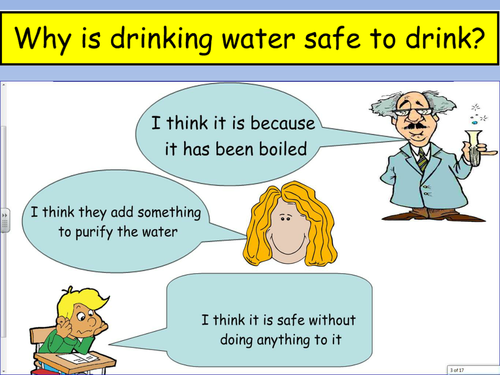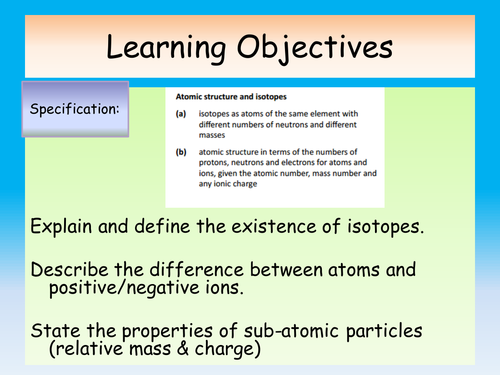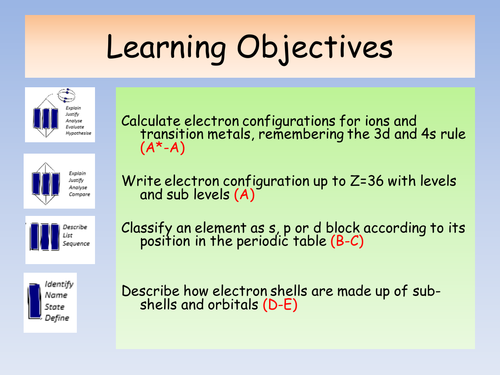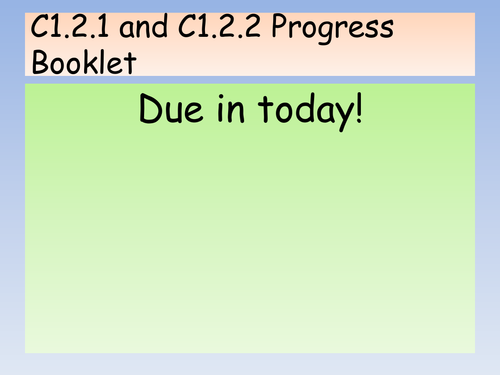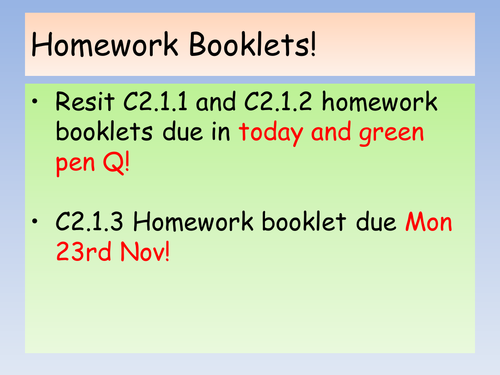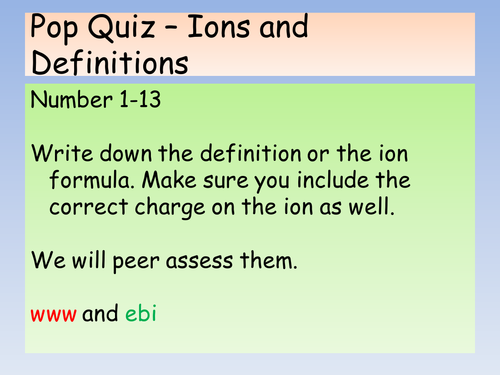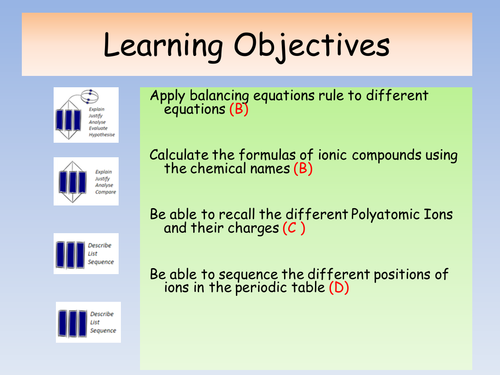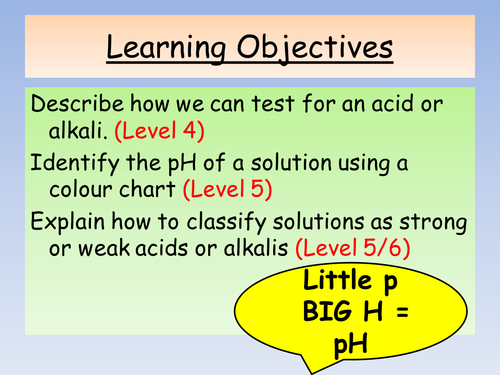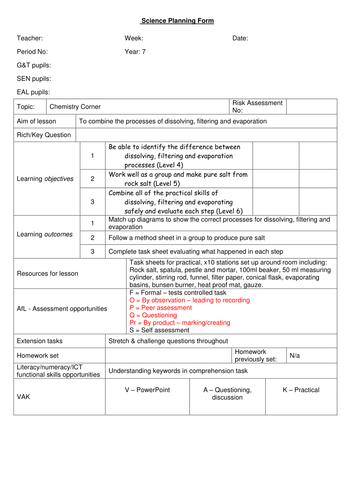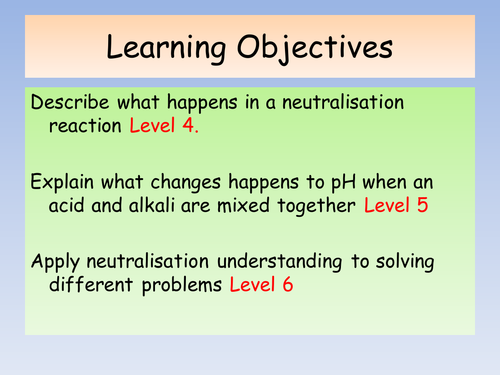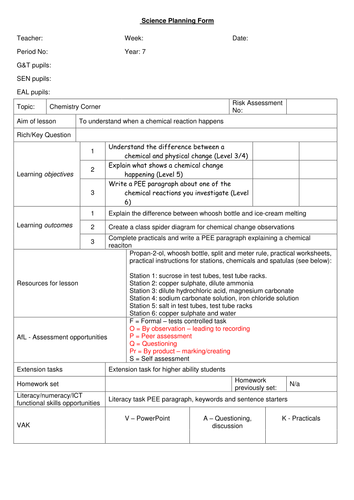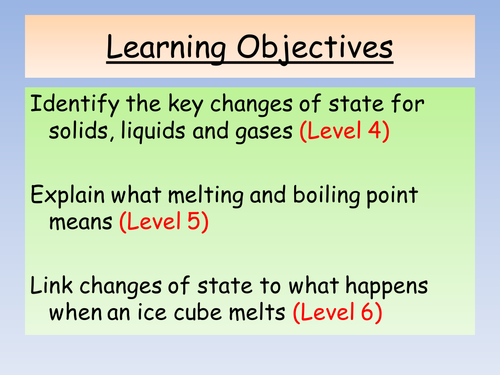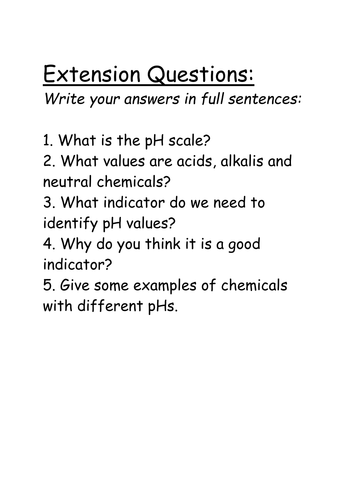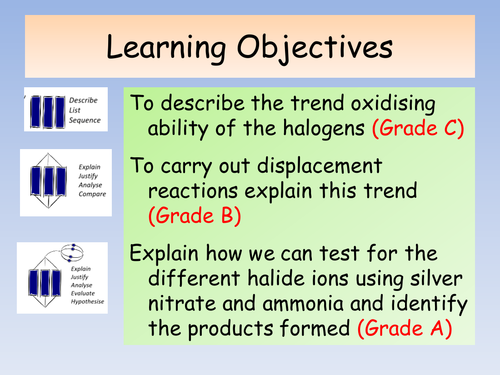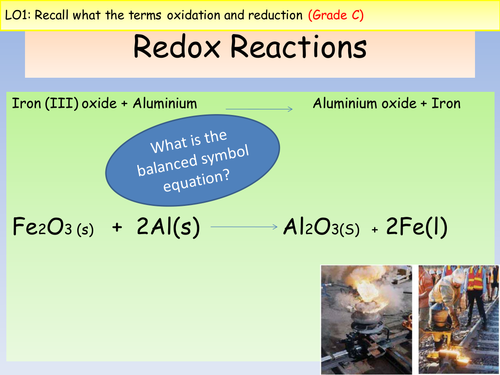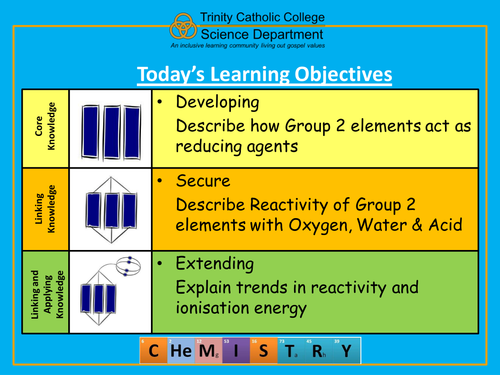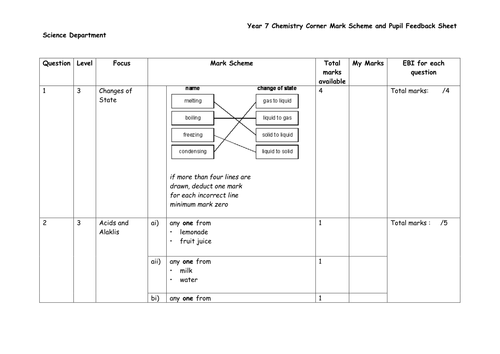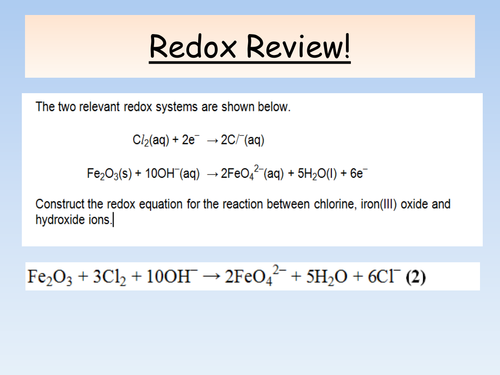
50Uploads
20k+Views
8k+Downloads
All resources

OCR A Level Chemistry A New Spec (from Sept 2015) - Periodicity and Reactivity Trends whole topics
This bundle of resources covers:
3.1.1 Periodicity
3.1.2 Group 2
3.1.3 The Halogens
3.1.4 Qualitative Analysis
The resource includes powerpoints for every lesson, practical activities including teacher/technician sheets, exam questions, mark schemes as well as the homework booklet and mark scheme covering these topics.
I hand out the homework booklet at the start of the topic (e.g. start of Periodicity) and collect it in at the end of the topic (Qualitative Analysis). The questions have been typed up from inside the OCR textbook as no electronic copy was available.
We use SOLO symbols to differentiate between different levels of progress.
Please let me know any feedback or improvements. More units to follow!

OCR A Level Chemistry A New Spec (from Sept 2015) - Disproportionation and uses of chlorine lesson
This is the third lesson in the Halogens topic 3.1.3 in the OCR Specification.
The powerpoint covers what disproportionation means, reactions of chlorine in water and the ethical uses of chlorine in water. There is an exam question and mark scheme to assess learning but there is also a literacy based task with articles from Greenpeace and WHO to compare the ethical uses of chlorine in water.

OCR A Level Chemistry A New Spec (from Sept 2015) - Atoms and Reactions whole topic
First topic in Module 2 - Foundations in Chemistry. All lessons fully resourced with powerpoints, worksheets progress sheet of the whole topic, AfL task on development of the atom and homework booklet with markscheme. I hand out the homework booklets at the start of every topic and collect in at the end to mark using www and ebi. The homework booklet questions have been sourced from the end of Chapter questions within the OCR textbook and typed up as no electronic copy was available. The mark scheme corresponds to the OCR pages in the textbook as well.
This is the first topic going from 2.1-2.1.2 according to the OCR Specification.
SOLO symbols are used to differentiate between tasks. Hope you find it useful and please let me know of any suggestions or improvements. More topics to follow!

OCR A Level Chemistry A New Spec (from Sept 2015) - Electrons, Bonding and Structure whole topic
2.2 topic in Module 2 - Foundations in Chemistry. All lessons fully resourced with powerpoints, worksheets and homework booklet with markscheme. I hand out the homework booklets at the start of every topic and collect in at the end to mark using www and ebi. The homework booklet questions have been sourced from the end of Chapter questions within the OCR textbook and typed up as no electronic copy was available. The mark scheme corresponds to the OCR pages in the textbook as well.
This is the whole topic for Electrons, Bonding and Structure fully resourced 2.2.1-2.2.2 according to the OCR Specification.
SOLO symbols are used to differentiate between tasks. Hope you find it useful and please let me know of any suggestions or improvements. More topics to follow!

OCR A Level Chemistry A New Spec (from Sept 2015) - Determination of Formulae lesson
This is the second lesson in the Amount of Substance topic in Module 2 - Foundations in Chemistry.
The powerpoint covers empirical and molecular formula, relative molecular mass, hydrated salts and water of crystallisation.
The worksheets will help with empirical formulae calculations (there is a help sheet if needed for weaker students) however there is also a stretch and challenge task on Ions for higher ability students to complete to differentiate.
The practical activity helps bring together empirical formula and water of crystallisation but also helps prepare students for PAG 1.3 prior to them completing their first PAG.

OCR A Level Chemistry A New Spec (from Sept 2015) - Moles, volumes and concentration lesson
This is the fourth lesson in the Amount of Substance topic in Module 2 - Foundations in Chemistry.
After PAG 1.3 has been performed I teach this lesson. The powerpoint covers moles, volume and concentration calculations and re-arranging the equations. converting between units and making up a standard solution using equations.
The worksheets help practice equation and calculation practice and there is a practical sheet for making up a standard solution for students and teachers.

OCR A Level Chemistry A New Spec (from Sept 2015) - The mole and Avogadro's constant lesson
This is the first lesson in the second topic The Amount of Substance in Module 2 - Foundations in Chemistry.
The powerpoint covers Avogadro's constant, the mole, molar mass and re-arranging the molar mass equation.
The activity is a good task to get students to understand what a mole is in terms of the number of atoms in your signature. The worksheets help introduce standard form and sig fig if needed to practice Maths skills as well as practicing re-arranging the molar mass equation.

OCR A Level Chemistry A New Spec (from Sept 2015) - Formulae and equations lesson
This is the third lesson I teach in the Atomic Structure and Isotopes lesson as part of Module 2 - Foundations in Chemistry.
The lesson powerpoint covers ionic charges, binary compounds, polyatomic ions, formulas of ions and balancing equations. There is also a longer and harder balancing equations worksheet and mark scheme. I have also uploaded the AfL task I set in this lesson for homework for students to research the development of atomic theory as well.

Chemistry Corner KS3 Year 7 Topic - Acids and Alkalis
This is the sixth lesson in a topic I made called Chemistry Corner for KS3 Year 7.
This lesson includes a powerpoint on what an acid and alkali are, pH scale, testing a circus of liquids
and recording results, extension questions and a homework sheet on acids and alkalis.
This scheme of work was made when KS3 Levels were used, so you may need to amend the levels according to your own assessment criteria used for KS3.

Chemistry Corner KS3 Year 7 Topic - Evaporation
This is the eleventh lesson in a topic I made called Chemistry Corner for KS3 Year 7.
This lesson includes a powerpoint on identifying dissolving, filtering and evaporation techniques from diagrams, what happens in evaporation and then a final group practical. This is a rock salt challenge so students are assessed on their group practical skills as well as their answers to the evaporation questions.
This scheme of work was made when KS3 Levels were used, so you may need to amend the levels according to your own assessment criteria used for KS3.

Chemistry Corner KS3 Year 7 Topic - Neutralisation Reactions
This is the eighth lesson in a topic I made called Chemistry Corner for KS3 Year 7.
This lesson includes a powerpoint on introducing neutralisation reactions using a rainbow fizz demonstration, general word equations, students doing their own mini neutralisation reaction, neutralisation problems such as nettle stings etc.
This scheme of work was made when KS3 Levels were used, so you may need to amend the levels according to your own assessment criteria used for KS3.

Chemistry Corner KS3 Year 7 Topic - Simple Chemical Reactions
This is the fourth and fifth lesson in a topic I made called Chemistry Corner for KS3 Year 7.
This lesson includes a powerpoint on identifying factors that suggest a reaction has happened, differences between physical and chemical reactions, a practical activity circus investigating x6 reactions and a literacy task explaining one of the practicals in the circus.
This scheme of work was made when KS3 Levels were used, so you may need to amend the levels according to your own assessment criteria used for KS3.

Chemistry Corner KS3 Year 7 Topic - Changes of State lesson
This is the second lesson in a topic I made called Chemistry Corner for KS3 Year 7.
This lesson includes a powerpoint on changes of state (I always purchase some dry ice to demonstrate sublimation in class), properties of solids liquids and gases as well as melting and boiling points. There are also differentiated activity sheets and an extension task on icebergs.
This scheme of work was made when KS3 Levels were used, so you may need to amend the levels according to your own assessment criteria used for KS3.

Chemistry Corner KS3 Year 7 Topic - Lessons 6-11
This bundle is for half of the topic (Lessons 6-11) as there are too many resources for me to upload the whole topic as a bundle, so I'm having to sell them as two separate bundles.
Lessons 6-11 cover:
Acids & Alkalis
Making your own indicator
Neutralisation reactions
Dissolving
Filtering
Evaporation
This scheme of work was made when KS3 Levels were used, so you may need to amend the levels according to your own assessment criteria used for KS3.

OCR A Level Chemistry A New Spec (from Sept 2015) - Halide ion test lesson
This is the second lesson in the Halogens topic 3.1.3 in the OCR Specification.
The powerpoint covers the displacement reaction trends, oxidising ability recap exam question and a practical sheet which covers halide ion test with silver nitrate, dilute and conc ammonia.
The lesson also includes a student practical worksheet as well as a teacher/technician worksheet.

Chemistry Corner KS3 Year 7 Topic - Filtering
This is the tenth lesson in a topic I made called Chemistry Corner for KS3 Year 7.
This lesson includes a powerpoint reviewing solvent, solute and solution from the previous lesson, introducing the key words filtrate and residue, mini plenary assessment worksheet and a desert island practical problem using filter paper and labelling a filtration practical.
This scheme of work was made when KS3 Levels were used, so you may need to amend the levels according to your own assessment criteria used for KS3.

OCR A Level Chemistry A New Spec (from Sept 2015) - Redox lesson and assessment
This is the redox lesson for Module 2 - Foundations in Chemistry.
I teach this lesson after completing PAG 2.1 with the students to consolidate their learning on Acids and Bases.
The powerpoint covers what redox means, how to calculate oxidation numbers, illustrating what is oxidised and reduced in a reaction and the exceptions.
I have also included the assessment I use called 10 for 10 (10 qs in 10 mins) which is multiple choice and I use to assess the students' learning of topics 2.1.1-2.1.5. There is a checklist on the front for students to colour code and re-read pages in the OCR textbook on the areas they need to improve.

OCR A Level Chemistry A New Spec (from Sept 2015) - Group 2 lesson
This is a lesson covering Group 2 elements, 3.1.2 in the OCR specification.
The powerpoint includes physical and chemical trends of group 2 metals. There is also a practical sheet which covers reactions of group 2 oxides, hydroxides and thermal decomposition of group 2 carbonates.

Chemistry Corner KS3 Year 7 Topic - End of Topic Test & Progress Planner
This is the end of topic assessment for the Chemistry Corner scheme of work.
There is also a front cover sheet using teacher and student assessment boxes for www and ebi. I have also included the progress planner to show the overall structure of the topic that students can stick into their books.
There is also a mark scheme and raw mark to level converter, however this scheme of work was made when KS3 Levels were used, so you may need to amend the levels according to your own assessment criteria used for KS3.

New AQA A Level Chemistry - Redox and Introduction to Electrochemical Cells
This lesson follows the new AQA A Level Specification Electrode Potentials and Cells 3.1.11.1
The lesson content covers:
Electrochemical cells and the role of the salt bridge
Daniell Cell Practical sheet (can be used as required practical 8)
Large cell diagram can be printed onto A3 and labels added
How to calculate electrode potentials
How to draw conventional representations of cells

